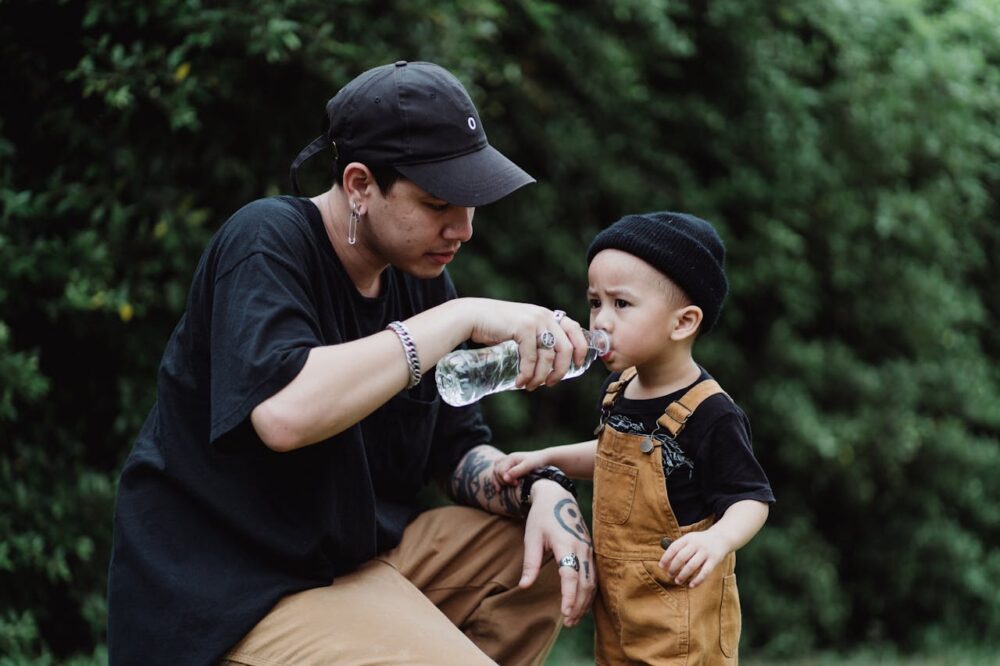How to Keep Your Children Properly Hydrated

Your child is having a blast at the playground, running and laughing. Then, out of nowhere, they slow down. They’re tired, cranky, and just not themselves. What’s going on? The answer might be simpler than you think – they need water.
As parents, we’re always trying to feed our kids healthy food. But there’s something else that’s just as important – keeping them hydrated. Water isn’t just a drink. It’s key to your child’s health and happiness.
In this article, we’ll cover everything you need to know about keeping your kids well-hydrated. We’ll talk about how to spot dehydration, why water matters so much, and how to make drinking water more fun. So grab yourself a glass of water (your kids will copy what you do!), and let’s get started.
Why Hydration Matters for Children
Water is essential for your child’s body to work properly. Here’s why it’s so important:
- It keeps them cool: When your child runs around on a hot day, they sweat to cool down. Without enough water, this cooling system doesn’t work well. They could overheat.
- It helps digestion: Water keeps things moving in the digestive system. It helps break down food and stops constipation, which can cause tummy aches.
- It’s good for the brain: When kids drink enough water, they’re more alert. They can remember things better and are often in a better mood. Who knew water could help with grumpiness?
- It’s great for skin: Water helps keep skin healthy. It’s a natural moisturiser that prevents dry, itchy skin.
- It helps the kidneys: The kidneys clean waste from the body. They need lots of water to do their job well.
Signs of Dehydration in Children
It’s important to catch dehydration early. Here’s what to look out for:
- Dry mouth and lips: If your child’s mouth feels dry and their lips look chapped, they need a drink.
- Changes in bathroom habits: Watch how often they go to the bathroom. If it’s less than usual, or if their pee is dark yellow, they need more fluids.
- Low energy: If your usually bouncy child becomes sluggish or grumpy, they might need water. It’s like their body’s battery is running low.
- Headaches: If your child complains of a headache, especially after playing outside, try giving them some water.
- Dizziness: If your child says they feel dizzy or seems unsteady, sit them down and give them some water right away.
Kids don’t always know when they’re thirsty, or they might forget to tell you. It’s up to us grown-ups to watch for these signs. If you spot them early, a few sips of water can make a big difference.
Keeping your kids hydrated doesn’t have to be hard work. With a bit of know-how and some simple tricks (which we’ll get to later), you can make sure your little ones stay healthy and hydrated. When kids are well-hydrated, they’re happier – and that makes everyone’s life easier!
How Much Water Do Children Need?
Water needs vary from child to child, but having a general guideline helps. Here’s a more detailed breakdown:
- Toddlers (1-3 years): About 4 cups (1 litre) per day. These little ones are always on the move. They need enough water to support their rapid growth and endless energy.
Offer water frequently, especially during and after active play.
- Preschoolers (4-8 years): About 5 cups (1.2 litres) per day. As kids start school, their water needs increase. They’re more active and their bodies are growing quickly. Make sure they have a water bottle for school and encourage sips throughout the day.
- Older kids (9-13 years): 7-8 cups (1.7-2 litres) per day. Preteens need more water as their bodies prepare for the growth spurts of adolescence. Sports and outdoor activities become more common, increasing their hydration needs.
- Teenagers (14-18 years): 8-11 cups (2-2.6 litres) per day. Teens need the most water. Their bodies are changing rapidly, and many are involved in sports or other physical activities. Boys typically need more than girls due to their larger body size and muscle mass.
These numbers are just starting points. Several factors can increase a child’s water needs:
- Climate: Hot or humid weather makes kids sweat more, increasing water loss.
- Physical activity: Sports, playground time, or any vigorous activity boosts water requirements.
- Illness: Fever, diarrhoea, or vomiting can quickly lead to dehydration. Increase fluid intake during sickness.
- Diet: If your child eats lots of fruits and vegetables (which contain water), they might need less to drink. On the other hand, salty or dry foods increase thirst.
- Body composition: Larger kids or those with more muscle mass typically need more water.
- Medications: Some medicines can act as diuretics, increasing water loss.
It’s crucial to remember that thirst isn’t always a reliable indicator, especially in children. By the time kids feel thirsty, they might already be mildly dehydrated. That’s why it’s important to offer water regularly throughout the day.
Here are some practical tips to ensure your kids get enough water:
- Start the day with a glass of water
- Always have water available during meals
- Pack a water bottle for school, outings, and car trips
- Offer extra water before, during, and after physical activities
- In hot weather, remind kids to drink more frequently
Don’t stress too much about hitting exact amounts every day. Instead, make drinking water a habit. If your child is peeing regularly and their urine is pale yellow, they’re likely well-hydrated. Trust your instincts. If your child seems thirsty or shows signs of dehydration, offer more water.
Other drinks count towards daily fluid intake too, but water is always the best choice. Milk is nutritious and hydrating, while fruit juices should be limited due to their high sugar content. Sports drinks are rarely necessary for kids unless they’re doing intense exercise for over an hour.
Keeping these guidelines in mind and making water easily accessible, will enable you help your kids develop healthy hydration habits that will benefit them for life. It’s not just about quenching thirst – it’s about giving their growing bodies and minds the foundation they need to thrive.
Creative Ways to Encourage Water Consumption
Let’s face it – some kids just don’t like water. Here are some tricks to make hydration more fun:
- Jazz up their cup: Let them pick out a special water bottle or use fun ice cube shapes.
- Fruity twist: Add slices of lemon, strawberries, or cucumber to their water. It looks pretty and tastes great.
- Be a water champion: Kids copy what they see. If you drink water often, they’re more likely to do the same.
- Make it a game: Create a sticker chart. Each glass of water earns a sticker. Full chart? Small prize time!
- Tech it up: For older kids, try a water tracking app. They might enjoy the challenge.
Best Times for Hydration
Timing is everything. Here’s when to focus on hydration:
- Morning kickstart: A glass of water when they wake up gets the day off to a good start.
- Mealtime habit: Serve water with every meal. It’ll become second nature.
- Before, during, and after play: Active kids need extra water, especially in hot weather.
- Bedtime sip: A small drink before bed is good, but not too much – unless you enjoy midnight bathroom trips!
Alternatives to Plain Water
Sometimes, kids need a break from plain water. Try these hydrating options:
- Milk: It’s not just tasty – it’s hydrating and packed with nutrients.
- Water-rich fruits: Watermelon, oranges, and grapes are like nature’s water bottles.
- Homemade popsicles: Freeze watered-down fruit juice for a cool treat.
- Herbal teas: For older kids, try caffeine-free options like mint or chamomile. Serve them iced in summer.
- Soup: A warm bowl of broth-based soup adds both hydration and comfort.
Mix it up with these options, but remember – water is still the hydration champion. These alternatives are great for variety, but shouldn’t replace water completely.
By making hydration a normal part of your family’s day, you’re setting your kids up for a healthier life. It might take some time and creativity, but soon enough, reaching for that water bottle will be as natural as breathing. Your kids’ bodies (and future selves) will thank you!
When to Seek Medical Attention
While keeping your kids hydrated is usually straightforward, there are times when you need to act quickly:
- Severe symptoms: If your child has extreme thirst, sunken eyes, or isn’t producing tears when crying, it’s time to see a doctor.
- Fever plus dehydration: This combo can be dangerous. If your child has a fever and shows signs of dehydration, seek medical help.
- Refusing to drink: If your child consistently refuses fluids for an extended period, consult your paediatrician.
- Heat-related illness: Watch for signs of heat exhaustion or heat stroke, like high body temperature, rapid breathing, or confusion. These require immediate medical attention.
Remember, you know your child best. If something doesn’t seem right, trust your instincts and consult a healthcare professional.
Conclusion: A Ripple Effect of Hydration
Keeping your children hydrated is more than just a daily task – it’s a gift of health that keeps on giving. By making water a central part of your family’s routine, you’re not just quenching thirst; you’re nurturing bodies, minds, and futures.
But as we wrap up, let’s zoom out for a moment. While we fret over which water bottle to buy or how to make water more appealing, millions of children around the world face a stark reality – no access to clean water at all.
At AquaMaya we are championing the cause to “Give Water, Give Life,”. We are working tirelessly to deliver clean water access to 10 million people in West Africa. Our goal is beyond quenching quenching thirst; it’s about reducing child mortality from waterborne diseases and opening doors to healthier, more prosperous lives.
So, as you implement the tips from this article, consider taking your efforts a step further. By supporting initiatives like ours, you can extend the ripple effect of your family’s hydration habits to touch lives across the globe. It’s a powerful reminder that water isn’t just a health issue – it’s a human right.
Here’s a thought to leave you with: Every time you hand your child a glass of clean, safe water, imagine the impact if every child had that same opportunity. It’s not just about keeping our own children hydrated; it’s about creating a world where every child has the chance to thrive.
So, fill up those water bottles, get creative with your hydration games, and remember – every sip your child takes is a step towards a healthier future. And if you can, consider supporting us at AquaMaya. Because when we give water, we truly give life.
Stay hydrated, stay healthy, and let’s work together to make clean water a reality for children everywhere.
Sources
3. https://www.webmd.com/parenting/cold-flu-dehydration-child
4. https://riseandshine.childrensnational.org/how-much-water-does-my-child-need/
5. https://www.healthline.com/health/how-much-water-should-I-drink
6. https://www.healthline.com/health/childrens-health/how-much-water-should-a-toddler-drink






